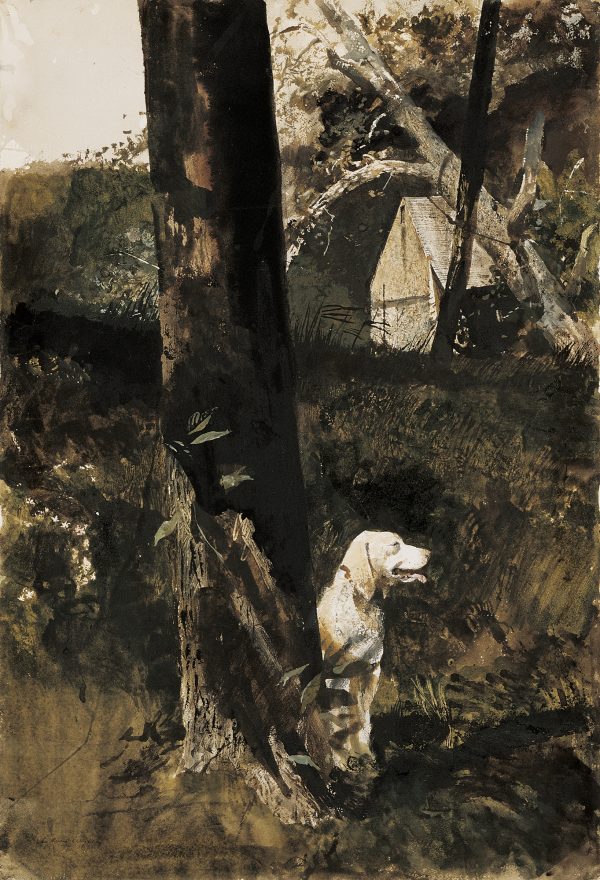
After the Chase
Wyeth, Andrew Newell
1965
Artwork Information
-
Title:
After the Chase
-
Artist:
Wyeth, Andrew Newell
-
Artist Bio:
American, 1917–2009
-
Date:
1965
-
Medium:
Watercolor and gouache on paper
-
Dimensions:
28 1/8 x 19 1/8 inches
-
Credit Line:
Wichita Art Museum, Gift of an anonymous donor in memory of Lee E. Phillips, Jr.
-
Object Number:
1979.54
-
Display:
Not Currently on Display
About the Artwork
Andrew Wyeth enjoyed wide public admiration in his long and successful career, but sometimes suffered from critical disdain of a realistic style that owed much to the techniques of his famous father, illustrator N.C. Wyeth. Painting primarily in tempera and occasionally in watercolor, Andrew Wyeth devoted his art to portraying the people and rural locales where he and his family lived, in winter Chadds Ford, Pennsylvania, and in summer Cushing, Maine. Wyeth is celebrated for his meticulous draftsmanship and clarity of detail. However, his realism never equated with passive description. Wyeth employed a selective eye—deleting or moving objects, restricting his color palette, manipulating light and shadow contrasts, and providing more linear detail than is optimum for the human eye—so as to achieve compositions that invited philosophical reverie.
After the Chase is typically Wyeth in its autobiographical reference. The principal figure, a handsome golden Labrador retriever seen seated in the foreground, panting slightly because he has presumably just completed a chase after some woodland creature, is one of the family pets.[1] In the background is a view of the back of one of the old structures comprising a local landmark called Brinton’s Mill. As is well known to Wyeth aficionados, the latter is a group of stone buildings operated in the 18th century as a gristmill that were restored for use as a home, studio, and storage facilities under the direction of Wyeth’s wife Betsy.
Because the scene is presented in brown shadows with only a patch of gray sky visible in the upper left and two isolated rays of sunlight penetrating the verdant browns and olive greens of the woods to illuminate the principal subjects of yellow dog and yellow building, the viewer feels that she has magically walked into the mind of Robert Frost where the woods are “lovely, dark, and deep.”[2] However, the intimations of decay and death so often primary in Frost’s poetry and Wyeth’s imagery are muted here. A warm comfortable silence surrounds the dog. He rests in sunlight, half closing an eye in contentment, while remaining alert to the scents and sounds of an awakening spring: the tiny white star-shaped blossoms of early anemones sparkle against the wet umber-colored ground on the left, and new growth appears in varied shades of green in vines, grasses, and leafy plants around the base of the large tree claiming center stage. For this moment of bliss, death recedes into the background, a destination placed on hold.
[1] In the 1961 painting of Betsy lying down in blueberry patch, hat over her face, with dog lying in the grass beside her, (Distant Thunder)Wyeth identified that dog as Rattler, Andrew Wyeth, Autobiography, introduction by Thomas Hoving (Little, Brown, and Company: Boston, New York, Toronto, London, in association with the Nelson-Atkins Museum of Art, Kansas City, MO, 1995), p. 57. The dog in After the Chase is similar in looks, and this painting dates four years later. However, the Wyeths often had more than one dog at a time and thus this may be Rattler or perhaps a bunkie of Rattler’s.
[2] Mahonri Sharp Young , “Wyeth and Manet in Philadelphia,” Apollo, Vol. LXXXVI: No. 57, Nov. 1966, made a very perceptive comment about the state of Maine, Wyeth’s Maine, that could well apply to Wyeth’s art as well, “It is a country of the mind, and a private one at that.” P. 403.